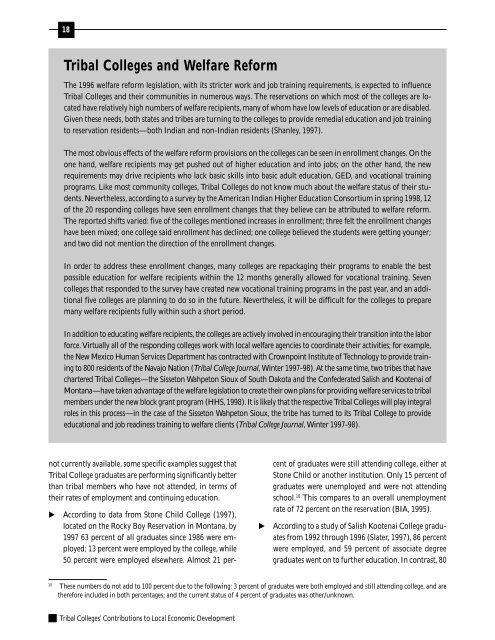Tribal College Contributions to Local Economic Development
Tribal College Contributions to Local Economic Development
Tribal College Contributions to Local Economic Development
- No tags were found...
Create successful ePaper yourself
Turn your PDF publications into a flip-book with our unique Google optimized e-Paper software.
18<strong>Tribal</strong> <strong>College</strong>s and Welfare ReformThe 1996 welfare reform legislation, with its stricter work and job training requirements, is expected <strong>to</strong> influence<strong>Tribal</strong> <strong>College</strong>s and their communities in numerous ways. The reservations on which most of the colleges are locatedhave relatively high numbers of welfare recipients, many of whom have low levels of education or are disabled.Given these needs, both states and tribes are turning <strong>to</strong> the colleges <strong>to</strong> provide remedial education and job training<strong>to</strong> reservation residents—both Indian and non-Indian residents (Shanley, 1997).The most obvious effects of the welfare reform provisions on the colleges can be seen in enrollment changes. On theone hand, welfare recipients may get pushed out of higher education and in<strong>to</strong> jobs; on the other hand, the newrequirements may drive recipients who lack basic skills in<strong>to</strong> basic adult education, GED, and vocational trainingprograms. Like most community colleges, <strong>Tribal</strong> <strong>College</strong>s do not know much about the welfare status of their students.Nevertheless, according <strong>to</strong> a survey by the American Indian Higher Education Consortium in spring 1998, 12of the 20 responding colleges have seen enrollment changes that they believe can be attributed <strong>to</strong> welfare reform.The reported shifts varied: five of the colleges mentioned increases in enrollment; three felt the enrollment changeshave been mixed; one college said enrollment has declined; one college believed the students were getting younger;and two did not mention the direction of the enrollment changes.In order <strong>to</strong> address these enrollment changes, many colleges are repackaging their programs <strong>to</strong> enable the bestpossible education for welfare recipients within the 12 months generally allowed for vocational training. Sevencolleges that responded <strong>to</strong> the survey have created new vocational training programs in the past year, and an additionalfive colleges are planning <strong>to</strong> do so in the future. Nevertheless, it will be difficult for the colleges <strong>to</strong> preparemany welfare recipients fully within such a short period.In addition <strong>to</strong> educating welfare recipients, the colleges are actively involved in encouraging their transition in<strong>to</strong> the laborforce. Virtually all of the responding colleges work with local welfare agencies <strong>to</strong> coordinate their activities; for example,the New Mexico Human Services Department has contracted with Crownpoint Institute of Technology <strong>to</strong> provide training<strong>to</strong> 800 residents of the Navajo Nation (<strong>Tribal</strong> <strong>College</strong> Journal, Winter 1997-98). At the same time, two tribes that havechartered <strong>Tribal</strong> <strong>College</strong>s—the Sisse<strong>to</strong>n Wahpe<strong>to</strong>n Sioux of South Dakota and the Confederated Salish and Kootenai ofMontana—have taken advantage of the welfare legislation <strong>to</strong> create their own plans for providing welfare services <strong>to</strong> tribalmembers under the new block grant program (HHS, 1998). It is likely that the respective <strong>Tribal</strong> <strong>College</strong>s will play integralroles in this process—in the case of the Sisse<strong>to</strong>n Wahpe<strong>to</strong>n Sioux, the tribe has turned <strong>to</strong> its <strong>Tribal</strong> <strong>College</strong> <strong>to</strong> provideeducational and job readiness training <strong>to</strong> welfare clients (<strong>Tribal</strong> <strong>College</strong> Journal, Winter 1997-98).not currently available, some specific examples suggest that<strong>Tribal</strong> <strong>College</strong> graduates are performing significantly betterthan tribal members who have not attended, in terms oftheir rates of employment and continuing education. According <strong>to</strong> data from S<strong>to</strong>ne Child <strong>College</strong> (1997),located on the Rocky Boy Reservation in Montana, by1997 63 percent of all graduates since 1986 were employed;13 percent were employed by the college, while50 percent were employed elsewhere. Almost 21 percen<strong>to</strong>f graduates were still attending college, either atS<strong>to</strong>ne Child or another institution. Only 15 percent ofgraduates were unemployed and were not attendingschool. 10 This compares <strong>to</strong> an overall unemploymentrate of 72 percent on the reservation (BIA, 1995).According <strong>to</strong> a study of Salish Kootenai <strong>College</strong> graduatesfrom 1992 through 1996 (Slater, 1997), 86 percentwere employed, and 59 percent of associate degreegraduates went on <strong>to</strong> further education. In contrast, 8010These numbers do not add <strong>to</strong> 100 percent due <strong>to</strong> the following: 3 percent of graduates were both employed and still attending college, and aretherefore included in both percentages; and the current status of 4 percent of graduates was other/unknown.<strong>Tribal</strong> <strong>College</strong>s’ <strong>Contributions</strong> <strong>to</strong> <strong>Local</strong> <strong>Economic</strong> <strong>Development</strong>
















